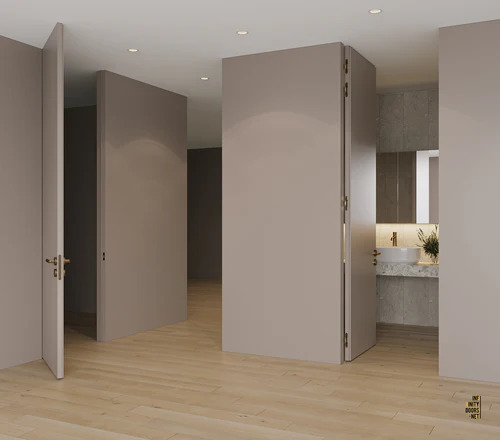Introduction
When designing or renovating a home, the type of door you choose might not seem like the biggest decision—but it has a significant impact on how a space looks and functions. Among the many options available, a right inswing door is one of the most practical choices for both modern and traditional interiors. Its ability to open inward to the right makes it intuitive, space-efficient, and easy to use.
But beyond its functionality, the real question is: how do you integrate a right inswing door seamlessly into your interior design? Let’s explore key design tips that can help you make the most of this style of door while ensuring your home feels cohesive and welcoming.
Design Tips for Seamlessly Integrating a Right In swing Door
1. Understand What a Right Inswing Door Is
Inswing doors are a bit different from outswing ones in that inswing doors open inward. As such, their opening method is different. For instance, a right inswing door, as the name implies, opens inward and has its hinges to the right side as you pull it open.
This orientation is more than just a technical detail—it influences furniture placement, traffic flow, and even the way natural light moves through your home. Knowing how the door functions helps you plan a layout that feels intentional rather than forced.
2. Plan Around the Swing Area
One of the most common mistakes homeowners make is overlooking the swing radius of a door. A right inswing door requires clear space on the inside where it opens, so it’s essential to account for this during the design phase.
- Furniture placement: Keep larger pieces like sofas, dressers, or cabinets away from the swing path to avoid a cramped look.
- Entryways and hallways: In narrower areas, ensure that the inswing does not block walkways or make the space feel too tight.
- Movement flow: Consider how people enter and exit a space. If the door opens smoothly without any blockage, the experience is better.
By planning for the swing, you avoid awkward arrangements and maintain a clean, open feel.
3. Match the Door Style to Your Interior Theme
A right inswing door can be much more than a functional entryway—it can also be a design statement. The trick is choosing a style that blends with or enhances your interior theme.
- Modern spaces: Opt for frameless, flush, or minimalistic designs that align with clean architectural lines.
- Traditional homes: Paneled doors or natural wood finishes add warmth and character.
- Transitional interiors: Neutral tones with subtle detailing strike a balance between old and new.
Think of your door as an extension of your walls, flooring, and furnishings. When it complements the larger design scheme, it feels like a natural part of the home rather than an afterthought.
4. Consider the Hardware
Hardware might seem like a small detail, but it can transform the look of your right inswing door. From hinges to handles, these accents influence both function and style.
- Handles and knobs: Sleek, matte finishes like black or brushed nickel work well in contemporary interiors, while polished brass or bronze adds a touch of tradition.
- Hinges: Concealed hinges can give your door a seamless, frameless appearance, especially in minimalist spaces.
- Locks and latches: If the door is for a bedroom or office, choose hardware that balances security and ease of use.
Coordinating the hardware with other fixtures in the room, such as light switches, cabinet handles, or lighting, creates design consistency.
5. Use Color to Blend or Contrast
The finish of your right inswing door plays a key role in its integration. You can either make the door blend seamlessly into the walls or use it as a contrasting feature.
- Blending in: Painting the door the same shade as your walls creates a clean, uninterrupted look. This works especially well in modern and minimalist homes.
- Creating contrast: A bold color or rich wood stain can make the door stand out as a feature piece, adding depth and personality to the room.
- Light and shadow: Consider how natural and artificial light interact with your chosen color or finish. A glossy finish may reflect light, while matte tones create a softer effect.
6. Pay Attention to Trim and Frames
While the door itself is important, the trim and frame around it also contribute to the overall aesthetic.
- Frameless look: Great for modern interiors, a flush design minimizes visual clutter.
- Detailed molding: Ideal for classic or transitional spaces, trim with subtle detail adds elegance and character.
- Consistency: Matching the trim to baseboards or window casings helps unify the entire room.
7. Think About Function Beyond Style
The best design isn’t just beautiful—it’s also functional. When integrating a right inswing door, consider the practical side.
- Room usage: In bedrooms, a right inswing door may provide more privacy since it naturally shields the view into the room.
- Climate and insulation: Inswing doors typically seal better against weather, making them efficient choices for exterior entrances.
- Accessibility: Ensure the door is easy to open and close for everyone in your household, especially in high-traffic areas.
8. Balance with Other Doors in Your Home
A single right inswing door might look fine on its own, but it’s even better when considered as part of the whole house design.
- Consistency: Keep door styles, colors, or finishes consistent throughout the home for a cohesive look.
- Variety with harmony: You don’t need every door to be identical—just ensure they complement each other. For example, a modern right inswing door can coexist with sliding or pocket doors if they share similar finishes.
Final Thoughts
Integrating a right inswing door into your home is more than just choosing a practical entry—it’s about blending functionality with design. By considering swing space, style, hardware, color, trim, and overall flow, you can make your door feel like a natural part of your living environment.
Whether you’re building new, remodeling, or simply upgrading a room, thoughtful planning ensures your right inswing door enhances both form and function. With the right design approach, it becomes more than just a way to enter and exit—it becomes a subtle, stylish detail that ties your home together.












